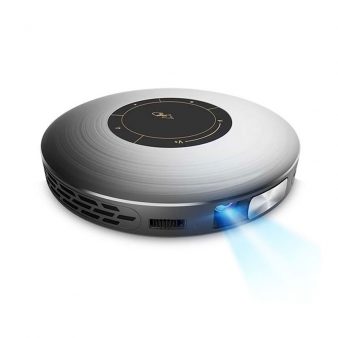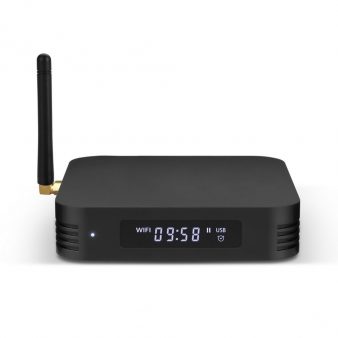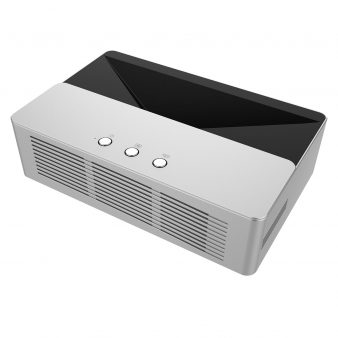瑞芯微RK3328芯片是一款专门面向中端影音市场的通用型SoC,支持主流格式的4K视频解码与输出,是三大开源平台之一,支持运行安卓系统、Linux系统和Linux发行版系统(Ubuntu、Debian等),非常适合定制项目。
1.1 Overview
RK3328 is a high-performance Quad-core application processor designed for Smart STB (Set Top Box) including OTT/IPTV/DVB. It is a high-integration and cost efficient SOC for 4K HDR STB.
Quad-core Cortex-A53 is integrated with separate Neon and FPU coprocessor, also with shared L2 Cache. The Quad-core GPU supports high-resolution display and game.
Lots of high-performance interface to get very flexible solution, such as multi-channel display including HDMI2.0a and TV Encoder (CVBS). TrustZone and crypto hardware are integrated for security. 32bits DDR3/DDR3L/DDR4/LPDDR3 provides high memory bandwidth.
1.2 Features
The features listed below which may or may not be present in actual product, may be subject to the third-party licensing requirements. Please contact Rockchip for actual product feature configurations and licensing requirements.
- Microprocessor
- Quad-core ARM Cortex-A53 CPU
- Full implementation of the ARM architecture v8-A instruction set
- ARM Neon Advanced SIMD (single instruction, multiple data) support for accelerated media and signal processing computation
- ARMv8 Cryptography Extensions
- In-order pipeline with symmetric dual-issue of most instructions
- Unified system L2 cache
- Include VFP v3 hardware to support single and double-precision operations
- Integrated 32KB L1 instruction cache, 32KB L1 data cache with 4-way set associative
- TrustZone technology support
- Full CoreSight debug solution
- One separate power domains for CPU core system to support internal power switch and externally turn on/off based on different application scenario
- PD_A53: Cortex-A53 + Neon + FPU + L1 I/D Cache of core 2/3
- One isolated voltage domain to support DVFS
- Memory Organization
- Internal on-chip memory
- BootROM
- Internal SRAM
- External off-chip memory①
- DDR3/DDR3L/LPDDR3/DDR4
- SPI Flash
- eMMC
- SD
1.2.3 Internal Memory
- Internal BootRom
- Support system boot from the following device:
- SPI Flash interface
- eMMC interface
- SDMMC interface (SDMMC0 only)
- Support system boot from the following device:
- Support system code download by the following interface:
- USB OTG interface (Device mode)
- Internal SRAM
- Size: 36KB
1.2.4 External Memory or Storage device
- Dynamic Memory Interface (DDR3/DDR3L/LPDDR3/DDR4)
- Compatible with JEDEC standards
- Compatible with DDR3-1866 / DDR3L-1866 / LPDDR3 / DDR4
- Support 32-bit data width, 2 ranks (chip selects), max 4GB addressing space per rank; total addressing space is 4GB(max) also
- Programmable timing parameters to support SDRAM from various vendors
- Low power modes, such as power-down and self-refresh for SDRAM
- Compensation for board delays and variable latencies through programmable pipelines
- Programmable output and ODT impedance with dynamic PVT compensation
- eMMC Interface
- Compatible with standard iNAND interface
- Compatible with eMMC specification 4.41, 4.51, 5.0 and 1
- Support block size from 1 to 65535Bytes
- Support three data bus width: 1-bit, 4-bit or 8-bit
- Support up to HS200; but not support CMD Queue and HS400
- SD/MMC Interface
- There are 2 SD/MMC interface
- Compatible with SD3.0, MMC 51
- Support block size from 1 to 65535Bytes
- Data bus width is 4bits
1.2.5 System Component
- CRU (clock & reset unit)
- Support clock gating control for individual components
- One oscillator with 24MHz clock input
- Support global soft-reset control for whole SoC, also individual soft-reset for each component
- Timer
- Six 64bits timers with interrupt-based operation for non-secure application
- Two 64bits timers with interrupt-based operation for secure application
- Support two operation modes: free-running and user-defined count
- Support timer work state checkable
- PWM
- Four on-chip PWMs with interrupt-based operation
- Programmable pre-scaled operation to bus clock and then further scaled
- Embedded 32-bit timer/counter facility
- Support capture mode
- Support continuous mode or one-shot mode
- Provides reference mode and output various duty-cycle waveform
- Watchdog
- 32-bit watchdog counter
- Counter counts down from a preset value to 0 to indicate the occurrence of a timeout
- WDT can perform two types of operations when timeout occurs:
- Generate a system reset
- First generate an interrupt and if this is not cleared by the service routine by the time a second timeout occurs then generate a system reset
- Programmable reset pulse length
- Totally 16 defined-ranges of main timeout period
- Interrupt Controller
- Support 3 PPI interrupt source and 128 SPI interrupt sources input from different components
- Support 16 software-triggered interrupts
- Two interrupt outputs (nFIQ and nIRQ) separately for each Cortex-A53, both are low-level sensitive
- Support different interrupt priority for each interrupt source, and they are always software-programmable
- Trust Execution Environment system
- Support TrustZone technology for the following components
- Cortex-A53, support security and non-security mode, switch by software
- BUS_DMAC, support some dedicated channels work only in security mode
- Secure OTP, only can be accessed by Cortex-A53 in secure mode
- Internal memory, part of space is addressed only in security mode, detailed size is software-programmable together with TZMA (TrustZone memory adapter)
- Cipher engine
- Support TrustZone technology for the following components
u Support AES 128/192/256
- Supports the DES (ECB and CBC modes) and TDES (EDE and DED) algorithms
- Supports MD5, SHA-1 and SHA-256 HASH algorithms
- Support PKA(RSA) 512/1024/2048 bit Exp Modulator
- Support 160-bit Pseudo Random Number Generator (PRNG)
- Support 256-bit True Random Number Generator (TRNG)
- Support secure OTP
- Support secure boot
- Support secure debug
- Support secure OS
1.2.6 Video CODEC
- Video Decoder
- MMU embedded
- Real-time decoding of MPEG-1/2/4, H.264, H.265/HEVC, VC-1, AVS, AVS+
- 264/AVC Base/Main/High/High10 profile @ level 5.1; up to 4Kx2K @ 60fps
- 265/HEVC Main/Main10 profile @ level 5.1 High-tier; up to 4Kx2K @ 60fps
- VP9, up to 4Kx2K @ 60fps
- VP8, up to 1080P @ 60fps
n MPEG-1, ISO/IEC 11172-2, up to 1080P @ 60fps
- MPEG-2, ISO/IEC 13818-2, SP@ML, MP@HL, up to 1080P @ 60fps
n MPEG-4, ISO/IEC 14496-2, SP@L0-3, ASP@L0-5, up to 1080P @ 60fps
- VC-1, SP@ML, MP@HL, AP@L0-3, up to 1080P @ 60fps
- MVC is supported based on H.264 or H.265, up to 1080P @ 60fps
- 264 Video Encoder
- Support video encoder for H.264 at BP/MP/HP @ 2
- Resolution and frame rate are up to 1920×1080 @ 30FPS②
- 1x1080p @ 30fps or 2x720p @ 30fps encoding
- Only support I and P slices, not B slices
- 265 Video Encoder
- Capable of encoding HEVC Main Profile @ L5.0 High-tier
- Resolution and frame rate are up to 1920×1080 @ 30FPS②
- 1x1080p @ 30fps or 2x720p @ 30fps encoding
- Only support I and P slices, not B slices
- In-loop deblocking filtering
- Loop filtering across slice
- Noise reduction
- Rate Control: VBR, CBR and ABR; ROI support
1.2.7 Audio CODEC
- MP3, AAC, WMA, FLAC, OGG,
1.2.8 JPEG CODEC
- JPEG decoder
- Decoder size is from 48×48 to 8176×8176(66.8Mpixels)
- Support JPEG ROI (region of image) decode
- Embedded memory management unit(MMU)
1.2.9 Image Enhancement Processor (IEP)
- Data format support
- BT601_l/BT601_f/BT709_l/BT709_f color space conversion
- YUV up/down sampling
- De-interlace
- Max resolution is up to 1920×1080
- Configurable high frequency de-interlace
- I4O2 (Input 4 field, output 2 frame) /I4O1B/I4O1T/I2O1B/I2O1T mode
1.2.10 Graphics Engine
- 3D Graphics Engine:
- OpenGL ES 1.1 and 2.0, OpenVG1.1
- 2D Graphics Engine:
- Support Pixel Format conversion between 601 and BT.709
- Max resolution is 3840×2160
- BitBLT, operation with two data source
- Color fill with gradient fill, and pattern fill
- High-performance scaling and rotation concurrently
- Monochrome expansion for text rendering
- New comprehensive per-pixel alpha (color/alpha channel separately)
- Alpha blending modes including Java 2 Porter-Duff compositing blending rules, chroma key, pattern mask, fading
- Dither operation
- 0, 90, 180 and 270-degree rotation
- x-mirror and y-mirror rotation operation
1.2.11 Video input interface
- TS interface
- Support one TS input channel (serial mode or parallel mode)
- Support 4 TS input mode: sync/valid mode in the case of serial TS input, nosync/valid mode, sync/valid, sync/burst mode in the case of parallel TS input
- Supports 2 TS sources: demodulators and local memory
- Supports one PTI (Programmable Transport Interface):
- 64 PID filters
- TS descrambling with 16 sets of Control Word under CSA v2.0 standard
- 16 PES/ES filters with PTS/DTS extraction and ES start code detection
- 4/8 PCR extraction channels
- 64 Section filters with CRC check, and three interrupt mode: stop per unit, full- stop, recycle mode with version number check
- PID done and error interrupts for each channel
- PCR/DTS/PTS extraction interrupt for each channel
- Supports 1 PVR (Personal Video Recording) output channel
- 1 built-in multi-channel DMA Controller
- Independent MMU for this module
- Camera Interface
- Support up to 5M pixels
- 8bits BT656(PAL/NTSC) interface
- YUV422 data input format with adjustable YUV sequence
- YUV422, YUV420 output format with separately Y and UV space
- Support static histogram statistics and white balance statistics
- Support image crop with arbitrary windows
- Support scale up/down from 1/8 to 8 with arbitrary non-integer ratio
1.2.12 Display interface
- Display interface
- Support HDMI 2.0a output up to 4K@60Hz
- TV interface: TV encoder and DAC for CVBS
- HDMI
- Compliant with HDMI 0a
- Support up to 4k x 2k @ 60Hz
- Support 3D video formats
- Support 4K P60 YCbCr444, YCbCr422, YCbCr420 in 10-bit and 12-bit display
- Support HDCP 1.4 and 2
- TV out interface
- 10-bit resolution DAC
- Composite (CVBS) output
- 480i/576i standard definition output
1.2.13 Video Output Processor
- There is one VOP (Video Output Processor)
n 24-bit (RGB888 YCbCr444), 30-bit (RGB101010, YCbCr 420, YCbCr 444)
- Max output resolution 4K for HDMI, 480i/576i for CVBS
- 4 display layers:
- Display layers: Win0, Win1, HWC and background
- One background layer with programmable 24bits color
- There are two OSD/video layers (win0/win1)
- RGB888, ARGB888, RGB565, YCbCr422, YCbCr420, YCbCr444,YCbCr 420 10bit,YCbCr 422 10bit,YCbCr 444 10bit
- maximum resolution is 4096×2304, support virtual display
- 1/8 to 8 scaling up/down engine with arbitrary non-integer ratio
- 256 level alpha blending (pre-multiplied alpha support)
- Support transparency color key
- Support BG, RG, RB swap, x/y mirror
- Support TV Encoder for PAL and NTSC
- YCbCr2RGB(rec601-mpeg/rec601-jpeg/rec709)
- YCbCr2RGB(BT2020)
- RGB2YCbCr(BT601/BT709)
- RGB2YCbCr(BT2020)
- Conversion between BT2020 and BT709/601
- Win0 and Win1 layer overlay exchangeable
- Support replication (16bits to 24bits) and dithering (24bits to 16bits/ 18bits) operation
- Blank and blank display
- HDR is supported with HDR10 and HLG modes
- Support tone mapping between HDR and SDR, including HDR2SDR and SDR2HDR
1.2.14 Audio Interface
- I2S0/I2S1 with 8ch
- I2S0/I2S1 supports up to 8 channels (8xTX or 8xRX)
- I2S0 is connected to HDMI internally, while I2S1 is for external device
- Audio resolution from 16bits to 32bits
- Sample rate up to 192KHz
- Provides master and slave work mode, software configurable
- Support 3 I2S formats (normal, left-justified, right-justified)
- Support 4 PCM formats (early, late1, late2, late3)
- I2S and PCM mode cannot be used at the same time
- I2S2/PCM with 2ch
- Up to 2 channels (2xTX and 2xRX)
- Audio resolution from 16bits to 32bits
- Sample rate up to 192KHz
- Provides master and slave work mode, software configurable
- Support 3 I2S formats (normal, left-justified, right-justified)
- Support 4 PCM formats (early, late1, late2, late3)
- I2S and PCM cannot be used at the same time
- PDM
- Up to 8 channels
- SPDIF
- Support two 16-bit audio data store together in one 32-bit wide location
- Support bi-phase format stereo audio data output
- Support 16 to 31-bit audio data left or right justified in 32-bit wide sample data buffer
- Support 16, 20 and 24-bit audio data transfer in linear PCM mode
- Support non-linear PCM transfer
- Audio codec
- 24bit DAC
- Support Line-out
- Support Mono, Stereo
- Integrated digital interpolation and decimation filter
- Sampling rate of 8kHz/12kHz/16kHz/24kHz/32kHz/44.1KHz/48KHz/96KHz
1.2.15 Connectivity
- SDIO interface
- Compatible with SDIO 3.0 protocol
- 4bits data bus widths
- Smart Card
- support card activation and deactivation
- support cold/warm reset
- support Answer to Reset(ATR) response reception
- support T0 for asynchronous half-duplex character transmission
- support T1 for asynchronous half-duplex block transmission
- support automatic operating voltage class selection
- support adjustable clock rate and bit (baud) rate
- support configurable automatic byte repetition
- GMAC 10/100/1000M Ethernet Controller
- Supports 10/100/1000-Mbps data transfer rates with the RGMII interfaces
- Supports 10/100-Mbps data transfer rates with the RMII interfaces
- There are 2 controllers, one is connected to internal FE PHY, the other is for external PHY device
- Supports both full-duplex and half-duplex operation
- Supports IEEE 802.1Q VLAN tag detection for reception frames
- Support detection of LAN wake-up frames and AMD Magic Packet frames
- Handles automatic retransmission of Collision frames for transmission
- Ethernet PHY
- Integrated IEEE 802.3/802.3u compliant 10/100Mbps Ethernet PHY
- Supporting both full and half duplex for either 10 or 100 Mb/s data rate
- Auto MDIX capable
- Supports wake-on-LAN, EEE
- 100Base-FX support
- Supports auto-negotiation
- USB 0
- Built-in 2 USB 2.0 interfaces, one supports OTG
- Compatible with USB 2.0 specification
- Supports high-speed(480Mbps), full-speed(12Mbps) and low-speed(1.5Mbps) mode
- Provides 16 host mode channels
- Support periodic out channel in host mode
- USB 3.0 Host
- Support up to 64 devices
- Support 1 interrupter
- Support 1 USB2.0 port and 1 Super-Speed port
- Support standard or open-source xHCI and class driver
- Support xHCI Debug Capability
- SPI interface
- Support serial-master and serial-slave mode, software-configurable
- Support 1 chip-select output in serial-master mode
- I2C interface
- Support 7bits and 10bits address mode
- Software programmable clock frequency
- Data on the I2C-bus can be transferred at rates of up to 100 kbit/s in the Standard- mode, up to 400 kbit/s in the Fast-mode or up to 1 Mbit/s in Fast-mode
- UART Controller
- Embedded two 64-byte FIFO for TX and RX operation respectively
- Support 5bit,6bit,7bit,8bit serial data transmit or receive
- Standard asynchronous communication bits such as start, stop and parity
- Support different input clock for UART operation to get up to 4Mbps or another special baud rate
- Support auto flow control mode
- One IR remote controller input channel
1.2.16 Others
- Multiple group of GPIO
- All of GPIOs can be used to generate interrupt to CPU
- Temperature Sensor(TS-ADC)
- The SAR ADC up to 50KS/s sampling rate
- -20~120℃ temperature range and 5℃ temperature resolution
- OTP
- Support standby mode
- Provide inactive mode, VP must be 0V or Floating in this
- Package Type
- TFBGA395L (body: 14mm x 14mm; ball size: 0.3mm; ball pitch: 65mm)
RK3328 Datasheet Rev 1.4
Notes:
① DDR3/LPDDR2/LPDDR3/DDR4 are not used simultaneously
② Actual maximum frame rate will depend on the clock frequency and system bus performance
③ Actual maximum data rate will depend on the clock frequency and JPEG compression rate





















